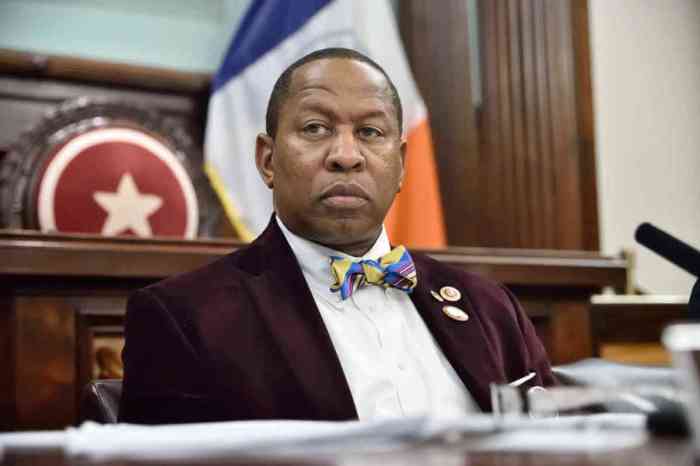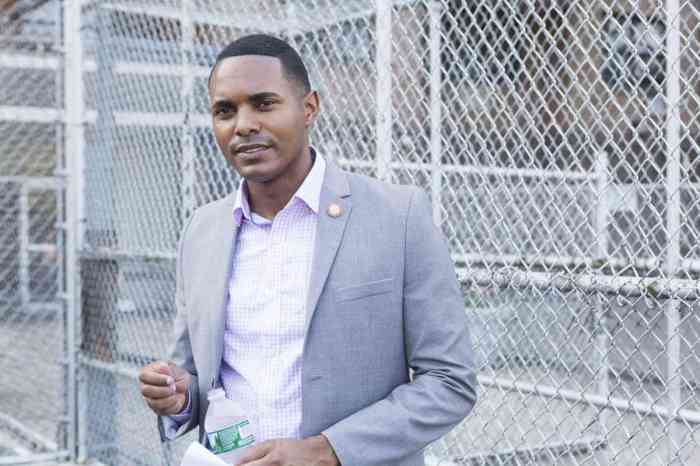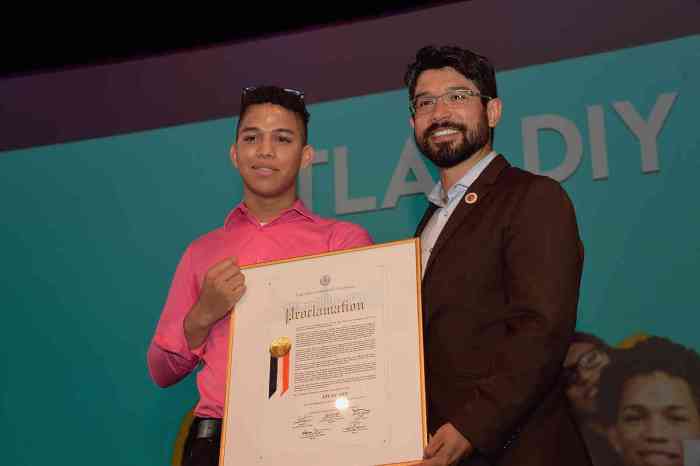Queens City Councilman Daniel Dromm, who chairs the Education Committee. | COUNCIL.NYC.GOV
After decades of dragging its feet on LGBT inclusion, the New York City public schools –– the nation’s largest school district –– took two big public steps forward in recent weeks in tandem with a hearing in the City Council Education Committee led by its new chair, Daniel Dromm, a veteran out gay Queens public school teacher.
On the eve of the February 25 hearing, the Department of Education (DOE) issued long-awaited Transgender Student Guidelines that are “intended to help schools ensure a safe learning environment free of discrimination and harassment, and to promote the educational and social integration of transgender students.”
The guidance calls this “an evolving area for school districts” that “will undoubtedly change over time.”
Dromm told Gay City News, “I made it clear to the chancellor that LGBT students were my top priority.”
Chancellor Carmen Fariña, at Dromm’s behest, attended his hearing.
Chancellor urges lessons on LGBT sensitivity, Council Ed Chair Daniel Dromm says issue his top priority
“The stories she heard from students were spellbinding,” Dromm said, including testimony from transgender student Rocky Sanabria, 15, of Queens, “who described what he had gone through. His principal in grade school told him he was going through a phase and was a tomboy and would get over it. He was made to stand in girls’ lines. He had a similar experience in middle school and was moved to special education. Now he’s in Maspeth High School where he complained one kid still bullied him, though the overall experience was wonderful.”
The DOE directive cautions that “school personnel should not disclose information that may reveal a student’s transgender status,” but adds that in “some cases, transgender students may feel more supported and safe if other students are aware that they are transgender.”
While it notes that certain records require use of the student’s legal name and birth gender, to “the extent that the school is not legally required to use a student’s legal name or gender on school records and other documents, the school should use the name and gender preferred by the student.”
The full guidelines are available online at tinyurl.com/lefsd3u.
The guidance says that students “should be addressed by school staff by the name and pronoun corresponding to their gender identity that is consistently asserted at school.” It also provides complex guidelines for bathroom and locker room use and participation in athletics, not all of which are satisfactory to advocates.
While the Transgender Legal Defense and Education Fund “commended” the DOE for issuing the guidelines, the group wrote in a release that they “fail to take a clear position with respect to competitive and contact sports. And they do not clearly require schools to allow transgender students to use bathrooms and other gender-segregated facilities that match their gender identity.”
Schools Chancellor Carmen Fariña with Mayor Bill de Blasio in December when he named her to her post. | GAY CITY NEWS
Following Dromm’s hearing, Fariña issued a “Chancellor’s Memo” to all principals that thanked the councilman for the hearing, stating, “We heard testimony from some remarkable young people who spoke movingly about their isolation and their determination to create an atmosphere of acceptance for themselves and their families.”
Fariña’s also wrote, “I encourage you and your staff to implement lessons and small group discussions that offer students –– especially those in middle and high school –– the opportunity to gain insight on and sensitivity toward the experience of their LGBT peers.”
Dromm said that the memo and the guidelines are “the culmination of 22 years of work that began with EColAGY [the Education Coalition on Lesbian and Gay Youth that lobbied for such changes in the 1990s] that tried to get the chancellor to put out a note to give [school personnel] the green light to move forward with lessons on tolerance for the LGBT community. Now we have what we need to move forward. Next step is they have to do these things. One of the students at my hearings asked, ‘Why isn’t there a Gay Straight Alliance in every school?’ I asked for a list. They are trying to compile it.”
Dromm pledged more oversight and more discussions with Fariña.
“Now we have to make sure it is implemented,” he said. “We have a chancellor who is on board. She put out this memo on her own and the wording was very good.”
Regarding the transgender guidelines, Kate Barnhart, executive director of New Alternatives for LGBT Youth (on whose board this reporter sits), said, “The situation is definitely getting better for trans youth in the schools, but a lot of trans youth end up not completing their education because they get bullied out of schools or wind up homeless because they get bullied out of school.”
Barnhart said in the case of many of her transgender clients, some from elsewhere but including some in New York, “schools have made an active effort to push them out of school. They start telling the client, ‘You really should just take the GED.’ Message is that they’re wasting the school’s time.”
Margie Feinberg, a spokeswoman for the DOE, wrote in an email, “We have never heard of this and we would never support this. This is an outrageous accusation.”
Barnhart said that there need to be more alternative high school slots in LGBT-sensitive settings and “they need to be accessible to those who are homeless or a little older.”
Barnhart also said that “trans youth are at disproportionate risk for HIV –– even higher than for gay male youth. The New York City public schools AIDS curriculum is very short on information for LGBT youth. And there are questions about whether the curriculum is even being implemented.”
In response to Barnhart’s assertions about the AIDS curriculum, DOE’s Feinberg wrote, “We offer a comprehensive program under state requirements.”
Asked what was new about the transgender guidelines, Feinberg wrote, “We have never had written guidelines for schools around supporting transgender youth. While many schools clearly used the practices in the guidelines, this new document provides clear direction for the school system.”
As to who was responsible for putting them together, she wrote that they are “based on national best practices.”
Responding to TLDEF’s criticisms that they do not go far enough regarding sports and use of gender-segregated facilities, she wrote, “These are the best practices –– we think they are clear and allow for responsiveness to the needs of individual students.”
But the Gay, Lesbian & Straight Education Network, while praising the school system’s efforts, echoed TLDEF’s concerns. In an email message, Daryl Presgraves, GLSEN’s director of communications, wrote, “Based on the guidelines released last week, the DOE took several GLSEN-recommended steps to ensure that transgender students are respected and supported in schools. The guidelines fall short of our recommendations in some areas, such as gender-segregated spaces and physical education/athletics, but we are grateful to the DOE for recognizing the need to provide schools with a roadmap for better supporting transgender students.”
Pauline Park, chair of the New York Association for Gender Rights Advocacy (NYAGRA), called the new guidelines “a necessary component in any effort to protect transgender and gender-variant students from discrimination and bias-based harassment” in the schools. “However, these guidelines give enormous discretion to school staff and Department of Education authorities to adjudicate disputes on a case-by-case basis, and so the true test of these new guidelines will lie in how teaching and non-teaching staff use them in practice.”
Park called for “transgender sensitivity training” for all school staff.
Transman Jay Kallio, whose LGBT activism goes back to the early 1970s, called the guidelines “long overdue.” In an email, he wrote, “As a young student [in New Jersey] in the 1960-70s, I was stalked, harassed, assaulted, and nearly blinded while at high school by the KKK in my community because of my gender nonconforming ways and sexual orientation. I was forced to drop out of high school because of the physical attacks and bigotry. Later when I nevertheless managed to get into a top college on the basis of near perfect SAT scores, I was also told to leave after a year by admissions staff, saying, ‘We don't want your kind here. Don't come back, you will never get anything good out of us.’”
Kallio also wrote, “There are many caveats and ‘wiggle room’ built into these DOE guidelines, with most recommendations subject to ‘case-by-case’ decision making. I would prefer to see the room for judgment weighted preferentially toward the needs, safety, and dignity of trans students, given their extreme vulnerability in the school environment. When policy is being decided regarding such a profoundly disadvantaged group, an ‘affirmative action’ set of protections and accommodations for past harm should be strongly considered.”




































